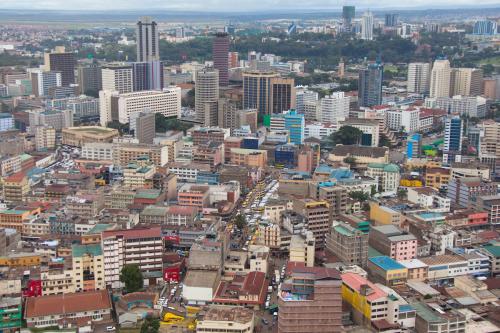Sub-Saharan Africa’s cities are receiving well-deserved attention: Propelled by rapid population growth, they are beginning to represent the best and worst of urbanization. In the best cases, as outlined in the Brookings Foresight Africa report, well executed urban growth in Africa can unlock “knowledge spillover, lower transaction costs, and cheaper provision of public goods.” Such benefits incentivize investors like the Abraaj Group and Actis to build their investment strategies around cities like Nairobi, Accra, and Lagos. Yet in cities across the continent, sprawling informal settlements simultaneously remove people from economic opportunity. These settlements, containing both low- and middle-income households, are now home to over 60 percent of Africa’s urban residents.
Strong urban planning is essential for cities across sub-Saharan Africa to remain attractive to investors and achieve inclusive economic growth. However, many municipalities in the region lack the institutional capacity, resources, and political authorities needed to effectively manage their growth. Multilateral organizations such as the World Bank have worked with municipal governments across the continent to create urban master plans, but institutional limitations at the local level leave these plans unexecuted. As local and national governments fail to control real estate development and contain urban sprawl, the benefits of urbanization are weakened.
Where local public sector enforcement of smart urban planning is missing, new interventions are needed to align private investment and development with urban plans that enable walkability, affordability, resilience, and equitable access to the promise of the city. One approach may be the use of concessional capital and risk guarantees from development finance institutions (DFIs), targeting investors and developers that build within and contribute to existing urban plans. But where to start?
Capturing potential and leveraging existing urban plans in Maputo, Mozambique
Maputo offers an opportunity to examine—and potentially apply—strategies that enable cooperation between planners and the private sector. Nearly 75 percent of the city’s population lives in informal settlements. At the same time, Maputo is well-placed to address sprawl and unlock equitable urban growth for three reasons: (1) It is relatively small and early in its growth trajectory compared to other cities in Africa; (2) it possesses the foundations for a well-planned city, including a downtown built along a grid framework and urban planning initiatives such as the World Bank’s Maputo Municipal Development Program; and (3) robust foreign investment into Mozambique (totaling $3.9 billion in 2015) can enable smart urban development through financing for housing, commercial real estate, and infrastructure.
Unfortunately, institutional incapacity and political infighting, coupled with an ongoing public debt crisis (tracing back to $1.16 billion in hidden debt and the suspension of International Monetary Fund support in 2016), have hindered the full realization of this potential.
Indeed, urban planners have worked to implement planned visions for the city. Between 2013 and 2014, the Baixa Partial Plan for Urbanization (or PPU, an initiative under the Municipal Development Program) developed a strategy to “improve the livability and economic competitiveness” of Maputo by revitalizing the Baixa, the city’s historic downtown. An appraisal completed by the PPU team in 2013 at the onset of the planning process found that “the domination of Baixa by economic interests has led to gradual collapse of residential life … [while] residential offerings are gradually pushed outward.” Residential projects represented only 15 percent of construction applications reviewed by the program, and the program found that existing residences in the Baixa were 40 years old on average—illustrating the lack of new residential development in the city center and some of the forces driving residential sprawl. The PPU sought to reverse these trends through plans to create affordable housing downtown and increase population density. But despite good intentions, the PPU’s goals were not met. Limited legal authority and resources at the municipal level to administer urban planning inhibited the program’s impact. Investors and real estate developers continue to pursue high-end developments downtown, building over plans for shared economic regeneration.
Local planners often feel powerless: A young architect and urban planner that we have spoken with, who worked on a number of urbanization and development initiatives including the World Bank Municipal Development Program, said that he has experienced few tangible results from his efforts. He helped place buildings in the Baixa on the national historical registry—slated for redevelopment as housing—only to see them torn down and replaced by commercial buildings. He still lives in central Maputo but has watched friend after friend move further into the urban periphery because of skyrocketing costs. Now, instead of working on urban development and planning projects, he spends much of his time designing houses that add to the sprawl he once fought to contain.
Another urban planner in Maputo expressed similar frustration. “People don’t want to go outside the city,” he said, “they want to stay in the middle,” where they can access economic opportunity. That’s increasingly unmanageable for many Mozambicans. Maputo’s post-independence growth and the rising cost of living downtown is reviving a segregated urban social structure once imposed under Portuguese colonial rule: The urban core is reserved for society’s elite, while middle- and low-income Mozambicans are forced into concentric bands on the outskirts of Maputo. Without mandated urban plans that encourage density and incentivize affordability, the “knowledge spillover, lower transaction costs, and cheaper provision of public goods” in Maputo’s planned urban center have become rare privileges rather than widely shared benefits.
DFIs can sweeten the deal for new urbanism
In the absence of a locally enforced urban plan that combats sprawl and enables density, utility delivery, and access to economic opportunity, urban planners and the private sector must align to pursue real estate development that is equitable and responsive to Maputo’s needs. Development finance institutions, including the International Finance Corporation (IFC) and the African Development Bank (AfDB), can incentivize this alignment—thus preserving and strengthening the benefits of urbanization—in three ways:
- By offering concessional financing (low-interest loans) and risk coverage (like credit guarantees or first-loss facilities) for real estate developers and investors that build within the frameworks laid out by master plans like those developed by the World Bank but unenforced by Maputo’s municipal government.
- By prioritizing dense, mixed-use, walkable, and inclusive developments for real estate investment. DFIs should target developments with space set aside for low- to middle-income residents and businesses—filling the role that tax credits for inclusive development play in developed markets.
- By dedicating infrastructure funding to service real estate investments that meet the two criteria above. In Maputo and elsewhere on the continent where public investment in infrastructure is limited, real estate developers bear significant cost for trunk infrastructure buildout (including utilities, sewage, drainage, and road connections).
Real estate currently plays a limited role in these DFIs’ portfolios. Of 300 investments in Africa disclosed by the IFC between 2008 and 2016, only 15 were in construction and real estate—a combination of investments into real estate funds and directly into projects. The African Development Bank focuses its real estate exposure solely on low-income housing, but these investments represent a small portion of its overall portfolio. Concessional financing for urban plan-aligned projects represent an opportunity for DFIs to expand their exposure to the real estate sector in a way that advances their core mission to drive equitable and sustainable economic growth.
Such a financing initiative is in the interest of private developers for two reasons. First, concessional financing and risk coverage would empower private firms to adopt real estate development strategies under the “new urbanist” doctrine—anticipating demand for walkable, mixed-use neighborhoods (already evident in such high-profile developments as Melrose Arch in Johannesburg and Garden City in Nairobi). This approach would help bypass the urban sprawl witnessed in the United States, China, and now sub-Saharan Africa, and could provide investors with more valuable assets over the long term. Second, funding from the IFC or AfDB for trunk infrastructure would absorb the cost of having to independently finance utilities and road connections (cited by the AfDB as representing 10 percent of housing construction costs in Kenya and estimated by a Mozambican real estate investor to constitute 30 percent of construction costs in Maputo).
The private sector can never fully replace the urban planning functions of a well-run municipal government. And a single strategy cannot fully address the growth of informal settlements. Still, DFIs can supplement a lack of municipal control over city growth and can encourage increased density and housing supply by incentivizing private sector alignment with existing urban plans. Maputo’s growth trajectory, unrealized urban plans, and influx of foreign investment make it a promising place to put these investment strategies into effect. Aligning incentives for private sector developers and investors with the frameworks set forth by urban planners can curtail the growth of informal settlements and ultimately contribute to long-term, inclusive growth in Africa—unlocking the benefits of urbanization for all.
Note: This blog reflects the views of the authors only and does not reflect the views of the Africa Growth Initiative.





Commentary
How development finance institutions can align the private sector with urban planning in Maputo
April 5, 2017